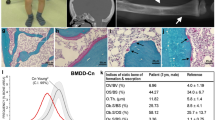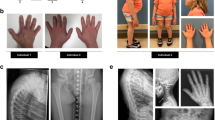Abstract
The expression of type X collagen is restricted to hypertrophic chondrocytes in regions undergoing endochondral ossification, such as growth plates. The precise function of type X collagen is unknown but the tissue–specific expression prompted us to examine the gene in hereditary disorders of cartilage and bone growth (osteochondrodysplasias). We have identified a 13 base pair deletion in one type X collagen allele segregating with autosomal dominant Schmid metaphyseal chondrodysplasia in a large Mormon kindred (lod score= 18.2 at Θ = 0). The mutation produces a frameshift which alters the highly conserved C–terminal domain of the α1(X) chain and reduces the length of the polypeptide by nine residues. This mutation may prevent association of the mutant polypeptide during trimer formation, resulting in a decreased amount of normal protein.
This is a preview of subscription content, access via your institution
Access options
Subscribe to this journal
Receive 12 print issues and online access
$209.00 per year
only $17.42 per issue
Buy this article
- Purchase on Springer Link
- Instant access to full article PDF
Prices may be subject to local taxes which are calculated during checkout
Similar content being viewed by others
References
Jacenko, O., Olsen, B.R. & LuValle, P. Organization and regulation of collagen genes. Crit. Rev. euk. Gene Exp. 1, 327–353 (1991).
Schmid, T.M. & Linsenmayer, T.F. A short chain (pro) collagen from aged endochondral chondrocytes. J. biol. Chem. 258, 9504–9509 (1983).
Yamaguchi, N., Benya, P.D., van der Rest, M. & Ninomiya, Y. The cloning and sequencing of α1 (VIII) collagen cDNA demonstrate that type VIII collagen is a short chain collagen and contains triple-helical and carboxyl-terminal non-triple-helical domains similar to those of type X collagen. J. biol. Chem. 264, 16022–16029 (1989).
Yamaguchi, N., Mayne, R. & Ninomiya, Y. The α1 (VIII) collagen gene is homologous to the α(X) collagen gene and contains a large exon encoding the entire triple-helical and carboxyl-terminal non-triple-helical domains similar to those of type X collagen. J. biol. Chem. 266, 4508–4513 (1991).
Sawada, H., Konomi, H. & Hirosawa, K. Characterization of the collagen in the hexagonal lattice of Descemet's membrane: its relation to type VIII collagen. J. cell Biol. 110, 219–227 (1990).
Gordon, M.K. & Olsen, B.R. The contribution of collagenous proteins to tissue-specific matrix assemblies. Curr. Op. Cell Biol. 2, 833–838 (1990).
Kwan, A.P.L., Cummings, C.E., Chapman, J.A. & Grant, M.E. Macromolecular organization of chicken type X collagen in vitro. J. cell Biol. 114, 597–604 (1991).
LuValle, P., Ninomiya, Y., Rosenblum, N.D. & Olsen, B.R. The type X collagen gene: intron sequences split the 5′ untranslated region and separate the coding regions for the non-collagenous amino-terminal and triple-helical domains. J. biol. Chem. 263, 18378–18385 (1988).
Muragaki, Y., Jacenko, O., Apte, S., Mattei, M.-G., Ninomiya, Y. & Olsen, B.R. The α2(VIII) collagen gene —a novel member of the short-chain collagen family located on the human chromosome 1. J. biol. Chem. 266, 7721–7727 (1991).
Apte, S.S. & Olsen, B.R. Characterization of the mouse type X collagen gene. Matrix 13, 165–179 (1993).
Apte, S., Mattei, M.-G. & Olsen, B.R. Cloning of human α1(X) collagen DNA and localization of the COL10A1 gene to the q21-q22 region of human chromosome 6. FEBS Lett. 282, 393–396 (1991).
Thomas, J.T. et al. The human collagen X gene. Complete primary translated sequence and chromosomal localization. Biochem. J. 280, 617–623 (1991).
Apte, S.S., Seldin, M.F., Hayashi, M. & Olsen, B.R. Cloning of the human and mouse type X collagen genes and mapping of the mouse type X collagen gene to chromosome 10. Eur. J. Biochem. 206, 217–224 (1992).
Orita, M., Iwahana, H., Kanazawa, H., Hayashi, K. & Sekiya, T. Detection of polymorphism of human DNA by gel electrophoresis as single-stranded conformation polymorphisms. Proc. natn. Acad. Sci. U.S.A. 86, 2766–2770 (1989).
Murray, V. Improved double-stranded DNA sequencing using the linear polymerase chain reaction. Nucl. Acids Res. 17, 8889 (1989).
Stephens, F.E. An achondroplasic mutation and the nature of its inheritance. J. Hered. 34, 229–235 (1943).
Lachman, R.S., Rimoin, D.L. & Spranger, J. Metaphyseal chondrodysplasias, Schmid type. Clinical and radiographic delineation with a review of the literature. Pediatr. Radiol. 18, 93–102 (1988).
Thomas, J.T., Kwan, A.P.L., Grant, M.E. & Boot-Handford, R.P. Isolation of cDNAs encoding the complete sequence of bovine type X collagen. Evidence for the condensed nature of mammalian type X collagen genes. Biochem. J. 273, 141–148 (1991).
Bächinger, H.P., Bruckner, P., Timpl, R., Prockop, D.J. & Engel, J. Folding mechanism of the triple helix in type-III collagen and type-III pN-collagen. Role of disulfide bridges and peptide bond isomerization. Eur. J. Biochem. 106, 619–632 (1980).
Bruckner, P., Bächinger, H.P., Timpl, R. & Engel, J. Three conformationally distinct domains in the amino-terminal segment of type III procollagen and its rapid triple helix leads to and comes from coil transmission. Eur. J. Biochem. 90, 595–603 (1978).
Bruckner, P. & Eikenberry, E.F. Procollagen is more stable in cellulo than in vitro. Eur. J. Biochem. 140, 391–395 (1984).
Dölz, R., Engel, J. & Kühn, K. Folding of collagen IV. Eur. J. Biochem. 178, 357–366 (1988).
Schmid, T.M., Popp, R.G. & Linsenmayer, T.F. Hypertrophic cartilage matrix. Type X collagen, supramolecular assembly, and calcification. Ann. N.Y. Acad. Sci. 580, 64–73 (1990).
Reginato, A.M., Lash, J.W. & Jimenez, S.A. Expression of type X collagen mRNA levels in embryonic chick sternum during development. J. biol. Chem. 261, 2897–2903 (1986).
Gibson, G.J. & Flint, M.H. Type X collagen synthesis by chick sternal cartilage and its relationship to endochondral development. J. Cell Biol. 101, 277–284 (1985).
LuValle, P., Iwamoto, M., Pacifici, M. & Olsen, B.R. Multiple, promoter-specific negative elements restrict type X collagen gene expression to hypertrophic chondrocytes. J.Cell Biol. 121, 1173–1179 (1993).
Orkin, S.H. in The Molecular Basis of Blood Diseases (eds Stamatoyannopoulos, G. et al.) 106–118 (Saunders, Philadelphia, 1987).
Wasylenko, M.J., Wedge, J.H. & Houston, C.S. Metaphyseal chondrodysplasia, Schmid type. J. Bone Joint Surg. 62A, 660–663 (1980).
International Working Group on Constitutional Diseases of Bone. International classification of osteochondrodysplasias. Am. J. med. Genet. 44, 223–229 (1992).
Ahmad, N.N. et al. Stop codon in the gene for type II procollagen (COL2A1) in a family with the Stickler syndrome (arthro-ophthalmopathy). Proc. natn. Acad. Sci. U.S.A. 88, 6624–6627 (1991).
Vissing, H., D'Alessio, M., Lee, B., Ramirez, F.R., Godfrey, M. & Hollister, D.W. Glycine to serine substitution in the triple helical domain of proα1(II) collagen results in a lethal perinatal form of short-limbed dwarfism. J. biol. Chem. 264, 18625–18627 (1989).
Sulisalo, T. et al. Cartilage-hair hypoplasia gene assigned to chromosome-9 by linkage analysis. Nature Genet. 3, 338–341 (1993).
Prockop, D.J. & Kivirikko, K.I. Heritable diseases of collagen. New Engl. J. Med. 311, 376–386 (1984).
Sweetman, W.A. et al. SSCP and segregation analysis of the human type X collagen gene (COL10A1) in heritable forms of chondrodysplasia. Am. J. hum. Genet. 51, 841–849 (1992).
Jacenko, O., Lu Valle, P.A. & Olsen, B.R. Spondylo metaphyseal dysplasia in mice carrying a dominant negative mutation in a matrix protein specific for cartilage-to-bone transfusion. Nature (in the press).
Author information
Authors and Affiliations
Rights and permissions
About this article
Cite this article
Warman, M., Abbott, M., Apte, S. et al. A type X collagen mutation causes Schmid metaphyseal chondrodysplasia. Nat Genet 5, 79–82 (1993). https://doi.org/10.1038/ng0993-79
Received:
Accepted:
Issue Date:
DOI: https://doi.org/10.1038/ng0993-79
This article is cited by
-
Identification of two novel COL10A1 heterozygous mutations in two Chinese pedigrees with Schmid-type metaphyseal chondrodysplasia
BMC Medical Genetics (2019)
-
The Effect of β-Aminopropionitrile on Skeletal Micromorphology and Osteogenesis
Calcified Tissue International (2018)
-
Short and tall stature: a new paradigm emerges
Nature Reviews Endocrinology (2015)
-
Identification and characterization of the novel Col10a1 regulatory mechanism during chondrocyte hypertrophic differentiation
Cell Death & Disease (2014)
-
Col10a1 gene expression and chondrocyte hypertrophy during skeletal development and disease
Frontiers in Biology (2014)



